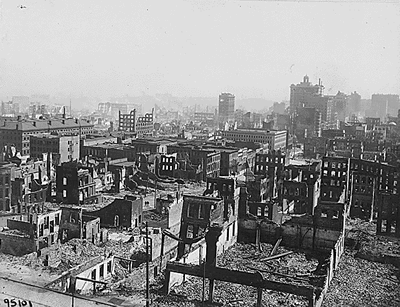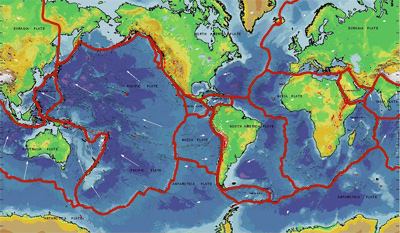Click on image for full size
National Archives Still Picture Records Section, Special Media Archives; Photograph by Department of Defense, Department of the Army, Office of the Chief Signal Officer
The Great San Francisco Earthquake of 1906
At 5:12 am on Wednesday April 18, 1906 most people in San Francisco, CA were still asleep. But they were about to wake up very suddenly.
The Earth shook violently - an earthquake. It lasted for only about a minute, but caused a lot of damage. Buildings toppled. People were trapped under rubble. Water and gas mains broke. Soon after the shaking had stopped, fires started burning in the city. The fires grew out of control and burned for three days.
The earthquake happened when there was a sudden movement along the San Andreas Fault. This large transform (strike-slip) fault is in California. It is the boundary between two of Earth's tectonic plates.
After the earthquake, an engineer named Herman Schussler explored the San Andreas Fault where it cuts through the mountains of the Coast Range. He testified in San Francisco's U.S. District Court in 1908 about what he saw.
"The remarkable feature of it was that the east mountains came four and a half feet closer to the west mountains than they were before," Schussler explained before the court.
Think about it. In only one minute, entire mountains had moved several feet.
"If San Francisco had been at or near the fault line there would not have been anything left of it," Schussler continued.
After the earthquake and fires, more than 500 of San Francisco's city blocks were in ruins. More than half of the people were homeless. People lived in tents and other shelters and cooked food outdoors. But it didn't take long for people to start picking up the pieces.
"San Francisco is beginning to rise again out of its ashes," wrote Samuel Fortier a week after the earthquake and fires. "There is no lack of confidence," he continued. "The courage of the people is simply remarkable. The thousands who have lost about all they possessed are wonderfully cheerful, and one seldom hears any whining."















